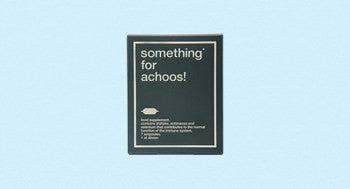
Winter Prevention
Winter attacks. Nature defends. Take a pack of something® for achoos! per month, between September and February. And the usual winter problems will be far away from you. By the way, we love to mix it into juices and porridge. Try it.
PROGRAM
3x something® for achoos! for three months.
HOW TO TAKE
1 ampoule in the evening. For 7 days. Repeat monthly. Between September and February.
Saffron (Crocus sativus)
CloseCrocus sativus, more commonly referred to as saffron is the most expensive spice in the world. It has been traditionally used as a spice, although recent studies have shown antidepressant properties. These properties are related to the serotonin metabolism, which have demonstrated effects on mood elevation as a result of increased activity of neurotransmitters in the body.
Folic acid
CloseFolic acid is a water soluble vitamin belonging to the b complex vitamins which are crucial for the formation of structural proteins and hemoglobin. It is mainly known for its importance in the prevention of congenital anomalies in the first trimester of pregnancy.
Artichoke (Cynara scolymus)
CloseArtichoke is high in vitamin C and minerals and is a powerful antioxidants that may help to prevent damage to the liver cells. It also protects the body against loss of unstable oxygen molecules, known as free radicals.
Artichoke helps support detoxification as well as the normal flow of digestive juices and contribute to the normal function of the intestinal tract.
Birch
CloseBirch (betula alba) is part of the betulaceae tree family. This tree has a long history of medical use in different countries and cultures in the treatment of skin diseases, especially eczema, as well as infections, inflammations, rheumatism, and urinary disorders.
Rosemary
CloseRosemary is widely used as a spice, especially in Mediterranean dishes.
Medicinally, it has been used to facilitate digestion, hepatobiliary drainage and to support the functioning of the gastrointestinal tract. Clinical studies have also demonstrated antioxidant properties, which may neutralize harmful particles in the body known as free radicals, which damage cell membranes, alter DNA and can even cause cell death.
Biotin
CloseBiotin, also known as vitamin b7, is part of the vitamin group that acts as coenzyme. It is a vital part of a healthy metabolism and creating important enzymes.
Bromelain
CloseBromelain belongs to a group of enzymes, responsible for the break-down of proteins, and is obtained from the fruit or stem of pineapple. Studies show that bromelain has antiedematosa, antithrombotic and anti-inflammatory property.
Milk Thistle (Silybum scolymusa)
CloseMilk thistle is a medicinal plant which has been used for over 2,000 years as a herbal remedy for a variety of diseases, particularly for the liver, kidney and gallbladder. Studies dating back to the first century indicate the use of this plant by the Romans as a liver protector. Clinical studies suggest that substances in milk thistle, especially similarina, a flavonoid, can benefit the liver by protecting and promoting cell growth and inhibit oxidation and inflammation.
White tea
CloseWhite tea is the infusion of the tea plant, camellia sinensis. Its leaves are harvested at a young stage, before undergoing any oxidation. For this reason, white tea has a larger amount of antioxidants and is often used to detoxify the body and
Black Tea
CloseBlack tea is one of four kinds of tea made from the camellia sinensis plant. It is called black tea as the exposure of the tea leaves to air, causes them to oxidation. This process transforms leaves into a dark brown color, and during this process, the flavor is enhanced. Black tea is used to improve mental alertness, as well as learning skills, memory and information processing.
Java tea
CloseJava tea is a plant and its leaves and stem tips are used to make medicine.
It is also used for bladder and kidney disorders, including bacterial infections and kidney stones; liver and gallbladder problems, including gallstones; gout; and achy joints (rheumatism).
Green tea
CloseGreen tea is the infusion of the tea leaves of the plant camellia sinensis. Polyphenols such as catechins, are the main constituents which give it its antioxidant properties, while alkaloids such as caffeine, are responsible for its stimulating effect. Green tea has been used for weight management, mainly due to the effect attributed to the interaction of its constituents (polyphenols and alkaloids).
Choline
CloseCholine is a vitamin-like, essential nutrient in the production of phosphatidylcholine, one of the most important structural building blocks of a living cell. It contribute to normal homocysteine metabolism, as well as to normal lipid metabolism and to the maintenance of normal liver functioning. It has only been choline can be found in vegetables such as collard greens.
Dandelion (Taraxacum officinale)
CloseTaraxacum officinale, also known as dandelion, is a vegetable that most people would call a weed. It is full of vitamin A, B, C and D and minerals such as iron, potassium and zinc. It is widely used in traditional herbal medicine, and its root is considered a gastrointestinal "medicine", supporting digestive and liver functioning.
Echinacea
CloseEchinacea is a plant from the daisy family and can only be found in eastern and central North America. It is widely used for prevention and treatment of infections of the upper respiratory tract. Studies show its effectiveness in reducing the symptoms and duration of colds. Its components have been described as beneficial for the healthy functioning of the immune system.
Lemon balm
CloseLemon balm is part of the mint family and often used to control colics in infants. It helps to promote physical well-being, contributing to a normal functioning of the intestinal tract and supports digestion. It is also used to reduce anxiety and irritability and helps to get a good sleep, maintain good cognitive functioning and promote mental and physical relaxation.
Yerba mate
CloseThe yerba mate is a medicinal plant used for centuries. It is particularly rich in alkaloids such as ophylline, obromine and caffeine. Due to its properties, yerba mate contributes to weight management through supporting fat degradation. It is also used as a stimulant and tonic contributing to resistance against mental and physical fatigue.
Bean dry extract
CloseWhite beans produce an alpha-amylase inhibitor which has been characterized and tested in numerous clinical studies. It has shown to inhibit the activity of alpha-amylase, which can help promote weight loss by interfering with the digestion of complex carbohydrates, decreasing its rapid absorption and favorably influence the insulin system, leading to a lower fat accumulation
Fennel
CloseFennel is a plant commonly used to reduce colics, diahrrea and the associated gastrointestinal symptoms such as bloating and abdominal cramps.
Royal jelly
CloseRoyal jelly is consumed as a health promoter worldwide. Its complex substance contains a unique combination of proteins (12-15%), glucides (10-12%), fats (3-7%), amino acids, vitamins and minerals. Its properties are anti-inflammatory, lower cholesterol and enhance the production of red blood cells.
Ginger (Zingiber officinale)
CloseGinger is a rhizome (a root vegetable, like potatoes) with twisted stems rich in medicinal properties, used for over 3000 years. It is a source of vitamin B6, copper, magnesium and potassium. Ginger roots are used frequently for all things health. It is used to fight certain diseases and health disorders, but the main pharmacological use is to fight gastrointestinal problems such as nausea, vomiting, stomach pain, diarrhea, flatulence and even gastric ulcers.
Ginseng
CloseGinseng is one of the most popular medicinal plants and has been used to promote proactive health, vitality and longevity in Asian countries for more than 2,000 years.
It contains B-vitamins and essential oils and scientific studies indicate that ginseng increases resistance to diseases, fatigue and stress.
Griffonia (Griffonia simplicifolia)
CloseGriffonia is a commonly used plant in the traditional African medicine. Its seeds are used for aphrodisiacs purposes and as an antibiotic. The leaves are commonly used for treating wounds and disorders of the bladder and kidneys. Griffonia has a very high content of 5-HTP, a naturally occuring amino acid, which converts directly into serotonin in the brain.
More recently, the plant has been used for the treatment of anxiety, depression, insomnia, migraine and headaches, as well as the regulation of appetite leading to weight loss in obese patients.
Inositol
CloseThe former designation for Inositol was Vitamin B8. Inositol is a coenzyme necessary for proper metabolism of fats. Together with Choline, it helps the liver in fat metabolism and to promote bile flow.
KiOnutrime-Cs®
CloseThe KiOnutrime-Cs® is a patented ingredient based on vegetable chitosan, a naturally occuring fiber free from GMO, gluten or other allergens. Chitosan binds to fat molecules and forms into small balls, which cannot be digested and consequently absorbed by the body.
Iceland Moss (Cetraria islandica)
CloseThe Iceland Moss is full of antioxidants, antimicrobials and genotoxics. It has been used for the treatment of irritated tissues, especially the mucous membrane. Often used to cure coughing, it eases dry cough and helps ease sore throats and contributes to the normal functioning of the immune system.
Nutriose®
CloseLemon (Citrus limonum)
CloseLemon is an important medicinal plant from the Rutaceae family and a key element in the ayurveda medicine. Several studies give prominence to the lemon as an important fruit for health promotion, due to its richness in phenolic compounds, as well as vitamins B and C, minerals, fiber, essential oils and carotenoids.
Papain
ClosePapain is a digestive enzyme extracted from papaya. This enzyme plays a key role in the digestion of hard to break down proteins. it has been commonly used in its native South America as a digestive support for meat eating.
Passionflower (Passiflora incarnata)
ClosePassionflower is used as an anxiolytic, calming and a sleep inducing promoter. It helps with relaxation and controlls anxiety and insomnia.
Mouse-ear hawkweed
ClosePlantago Menor (Plantago lanceolata)
ClosePlantago Menor contains mucilage which has a calming effect in the mouth and vocal cords, providing relief of irritation of the pharynx and throat.
Propolis
ClosePropolis is a substance produced by bees, consisting of a mixture of resins, wax and pollen. It is used by the bees inside the hive to prevent microbial growth. Based on this feature, propolis is widely used in products for defense and strengthening of the immune system.
Shiitake (Lentinus edodes)
CloseShiitake, known as Xiang Gu or "fragrant mushroom" in China, is the second most common edible mushroom grown worldwide. It is an important ingredient in Chinese and Japanese cuisine. The health benefits of shiitake are not widely known, but the number and quality of scientific studies are rapidly increasing. Shiitaki has immunomodulatory, antitumor, antiviral properties, as well as effects on cholesterol regulation.
White nettle
CloseVitamin A
CloseVitamina B1
CloseVitamin B1 is one of 8 B vitamins, which help the body to convert food into energy. Thiamine contributes to normal energy producing metabolism, for the normal functioning of the nervous system to a normal psychological function and normal functioning of the heart.
Glucuronolactone
CloseGlucuronolactone is a small molecule that contributes to the structure of connective tissues. Combined with toxic substances, glucuronolactone converts them into water solubles that can be excreted in urine. It is commonly used in energy drinks because of its detoxifying effects. Combining glucuronolactone with other substances like caffeine has positive effects on performance that require focus and attention. In addition to the benefits on cognition, glucuronolactone has been recognized to be important for detoxifying the human body.
Vitamina B2
CloseVitamin B2, also called riboflavin, is one of 8 B vitamins. All B vitamins help the body to convert carbohydrates into fuel (glucose).
Vitamin B2 contributes to normal energy producing metabolism, for the normal functioning of the nervous system, for the maintenance of normal red blood cells, for maintaining normal skin, for maintaining a vision, for normal iron metabolism, for the protection of cells against undesirable oxidation and reduction of fatigue and fatigue.
The food highest in vitamin B2 are almonds.
Niacin (Vitamina B3)
CloseNiacin is a vitamin and one of the essential nutrients for the human body. Niacin contributes to the normal energy metabolism production, the normal functioning of the nervous system, the normal psychological function for the maintenance of normal mucous, to maintain a normal skin and to reduce the tiredness and fatigue.
Vitamina B6
CloseVitamin B6 is also called pyridoxine. It is involved in the process of making serotonin and norepinephrine, which are chemicals that transmit signals in the brain. It contributes to the normal functioning of the nervous system, to normal metabolism of homocysteine, to normal metabolism of protein and glycogen, to a normal psychological function and many more.
Vitamin B12
CloseVitamina C
CloseVitamin C is a water-soluble vitamin, which your body does not store. You have to get what you need from food on a daily base. Vitamin C has many health benefits, such as contibuting to the nomal functioning of the immune system orproduction of collagen in our body.
The fruit highest in vitamin c is the kakadum fruit, native in australia, Kakadu Plums contain over 20 imes as much vitamin C as oranges.
Vitamin E
CloseWatercress (Nasturtium officinale)
CloseWatercress is part of the cabbage family and used for digestive problems and lack of appetite. Due to its large sulfur and calcium content, it is often used to treat poor digestion.
Gentian (Gentiana lutea)
CloseGentian is a flowering plant und traditionally used to facilitate digestion, but also to treat loss of appetite, bloating and flatulence. Its bitter constituents aid the stimulation of the taste buds, increasing the secretion of saliva and digestive juices.
Chicory (Cichorium intybus)
CloseChicory contributes to the stimulation of digestive juices and improves the gastrointestinal movements. It is extremely rich in inulin, a fiber which helps maintaining a healthy intestinal bacterial flora.
Acerola berry (Malpighia glabra)
CloseThe acerola berry is rich in vitamin C and therefore often used for cold and flu prevention. 100 g of acerola contain between 1000 and 2330 mg vitamin C, approximately 20 times more that 100 g oranges (57 mg) and kiwi (72 mg). Vitamin C helps the normal functioning of the immune system.
N-acetilcisteine
CloseN-acetylcysteine is a mucolytic agent used for long-term cough. It promotes fluidization of mucus. The decrease of mucus viscosity is achieved by the breaking down of the protein bonds, which facilitates their removal when coughing.
Anise (Pimpinella anisum)
CloseAnise is one of the medicinal plants that has been used for different purposes in traditional Iranian medicine. Several studies on its essential oil extract reveal antimicrobial, antifungal, antiviral and antioxidante properties. Anise is also used for gastric protection.
Camomile (Matricaria chamomilla)
CloseCamomile has been used for centuries as medical plant, due to its sedative and anxiolytic properties, and is rich in flavonoids such as apigenin and luteolin.
Black Raddish (Raphanus sativus)
CloseBlack radish contains a high concentration of glucosinolates. Experimental studies have demonstrated that the aqueous extract and juice of this root have pharmacological properties, especially antioxidante properties. In traditional Mexican medicine, black raddish has been used to treat hypercholesterolaemia, gallstones and to reduce fat levels in the blood.
Boldo (Peumus boldus)
CloseBoldo is used in traditional medicine to treat liver and gastrointestinal diseases. The leaves of the boldo plant are rich in antioxidants, especially flavonoids and alkaloids and have traditionally been used for the treatment of liver and bladder diseases as well as rheumatism. Recent research suggests that boldo may protect the liver from toxins, stimulate the gallbladder and reduce inflammation.
Fumitory (Fumaria officinalis)
CloseFumitory is a plant biochemically recognized for its wealth of active components like isoquinoline. It has been used in traditional medicine as anti-hypertensive, diuretic and hepatoprotective. The plant has also been pharmacologically evaluated and shown to possess antipyretic, anti-infectious and hypoglycaemic properties.
Peppermint (Mentha piperita)
ClosePeppermint has been used in traditional Eastern and Western medicine as a antispasmodic, aromatic, antiseptic treatment for colds, aches, indigestion, nausea and sore throats.
Omega 3 – DHA
CloseDHA or docosahexaenoic acid, is one of the constituents of the omega-3 and is the most abundant omega-3 fat in our brains.
Omega-3 - DHA is an essential fatty acid involved in the process of concentration, attention and memory and contributes to maintenance of normal brain function.
White bean (Phaseolus vulgaris)
CloseWhite beans produces phaseolamine, an alpha-amylase inhibitor which has been characterized and tested in numerous clinical studies. It has been shown to inhibit the activity of alpha-amylase, which can help promote weight loss by interfering with the digestion of carbohydrates and their conversion into simpler sugars.
Tyrosine
CloseTwenty percent of the human body is made up of protein. Protein plays a crucial role in almost all biological processes and amino acids are the building blocks of it. Tyrosine is one of the 22 amino acid.
It is essential for the synthesis of some neurotransmitters, including dopamine, norepinephrine and epinephrine, with direct action on the central and peripheral nervous system.
Melatonin
CloseMelatonin is a hormone produced by the pineal gland, the “principal seat of the soul.” in our brain, and is primarily responsible for the regulation of sleep. It is synthesized from tryptophan, an essential amino acid provided through the foods we eat. Its production decreases throughout life, which is why, with age, we tend to sleep less and have greater difficulty falling asleep. Taking 1 mg of melatonin per day contributes to reducing the time required to fall asleep.
Probiotics
CloseProbiotics are live-microorganisms often called “good bacteria” for our body. The human body hosts 4000-5000 different spacies of bacteria, which are essential for our health. Probiotics support digestion, maintain a healthy gut flora and are support immune health.
Vitamin D (colecalciferol)
CloseVitamin D is a fat-soluble vitamin that plays a role in many important body functions. It is best known for working with calcium in your body to help build and maintain strong bones. It contributes to normal absorption / utilization of calcium and phosphorus. Normal calcium levels in the the blood are important for the maintenance of normal bones, normal muscle functioning, maintenance of normal teeth, the normal operation of the immune system and the process of cell division.
Gotu kola (Centella asiatica)
CloseGotu Kola is used to treat difficulties with concentration, cognitive development and helps maintain good cognitive performance. It is often used to treat inflammation, stress and also insomnia.
Rhodiola
CloseL-arginina
CloseArginine is an semi-essential or conditionally essential amino acid in humans. It is one of the amino acids more metabolically versatile and is essential for cell devision and healing of wounds. In dietary supplements, it is mainly used by athletes because this amino acid is responsible for the production of nitric oxide. Nitric oxide improves blood microcirculation promoting efficient oxygen delivery to the tissues.
Glutamic Acid
CloseMagnesium
CloseCopper
CloseCopper is a key mineral. It contributes to the maintenance of normal tissue, to normal iron transport in the body, to normal skin pigmentation, to normal functioning of the immune system and to protect cells against undesired oxidations.
Phosphorus
ClosePhosphorus is a mineral part of the trace elemento family. It contributes to normal energy metabolismo, to the normal functioning of the cell membranes and to the maintenance of normal bonés and teeth.
Potassium
ClosePotassium is an essential electrolyte, a mineral that the body needs to function correctly. It contributes to the normal functioning of the nervous system, normal muscle function and the maintenance of normal blood pressure.
Chromium
CloseChromium is a trace element, which contributes to the normal metabolism of macronutrients and to maintain normal levels of blood glucose.
Manganese
CloseManganese is a trace element, of which the human body only requires very small amounts. Maganese contributes to normal energy metabolism and to the protection of cells against undesired oxidations.
Selenium
CloseSelenium is a mineral. It contributes to a normal spermatogenesis in maintaining normal hair, to the maintenance of normal nail, a normal functioning of the immune system, a normal thyroid function and to the protection of cells against undesired oxidations.
Zinc
CloseZinc is a trace element important to our metabolismo and our health. It has a number of health benefits, such as contributing to a normal cognitive function, a normal synthesis of DNA and many more.


